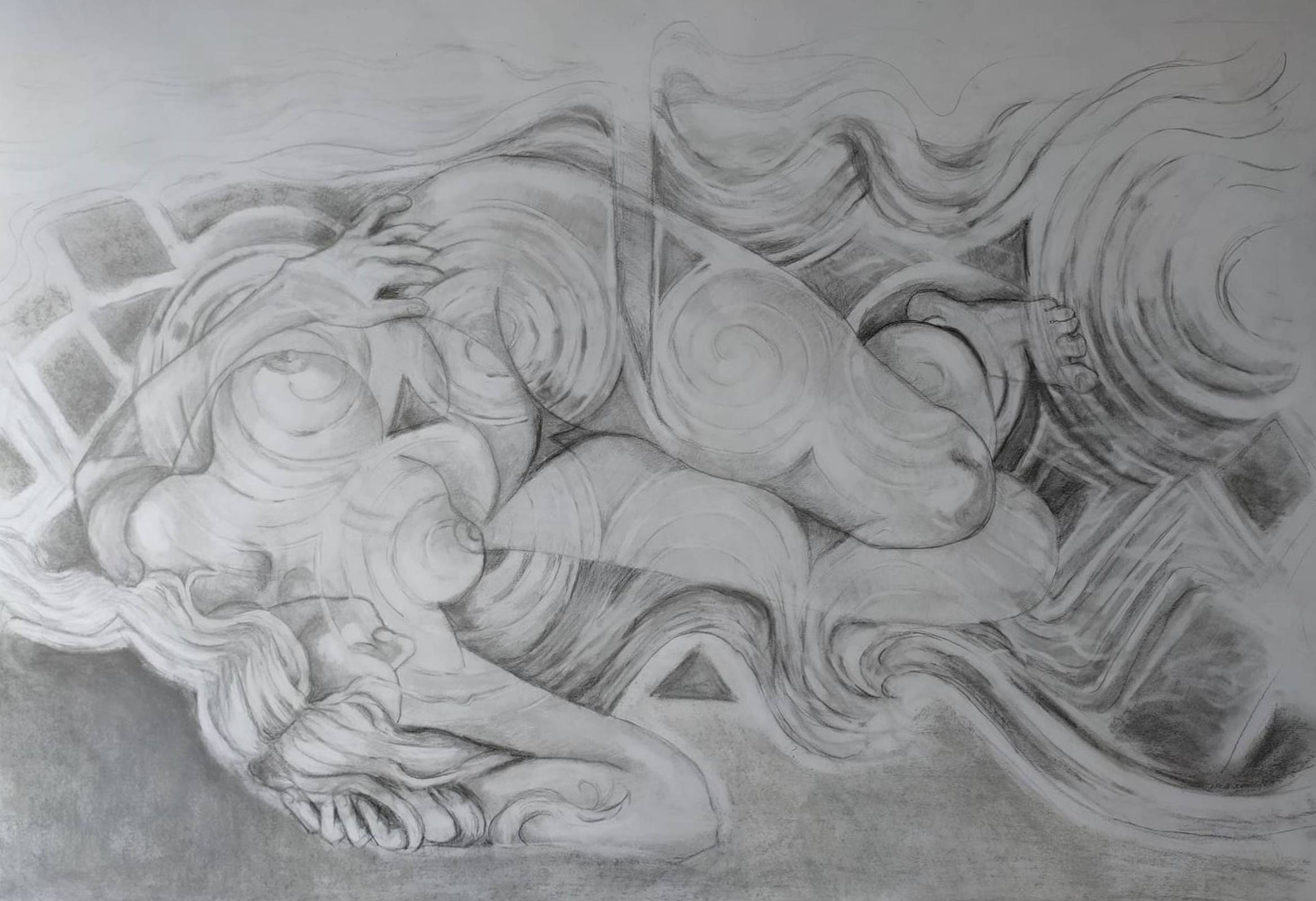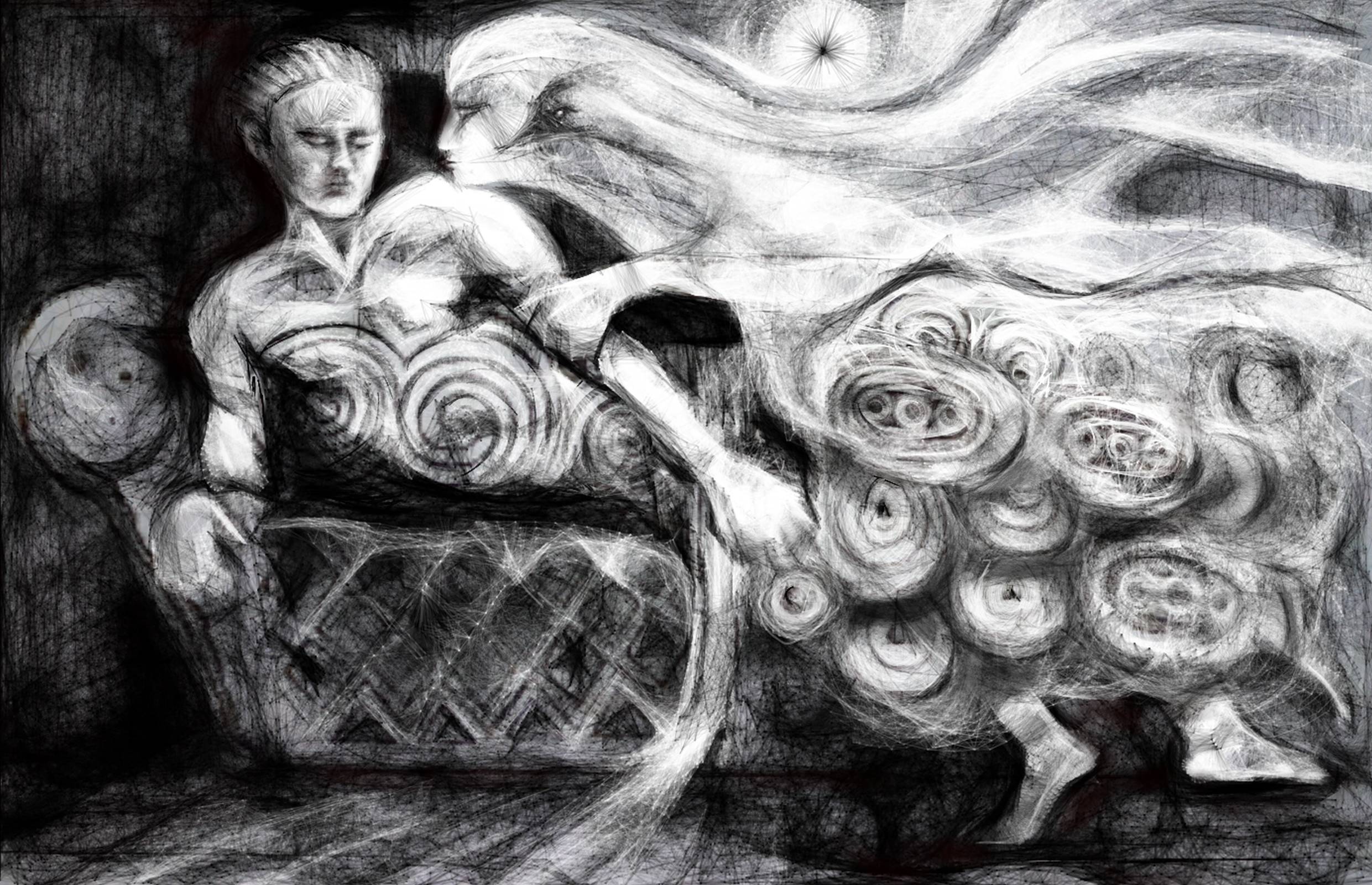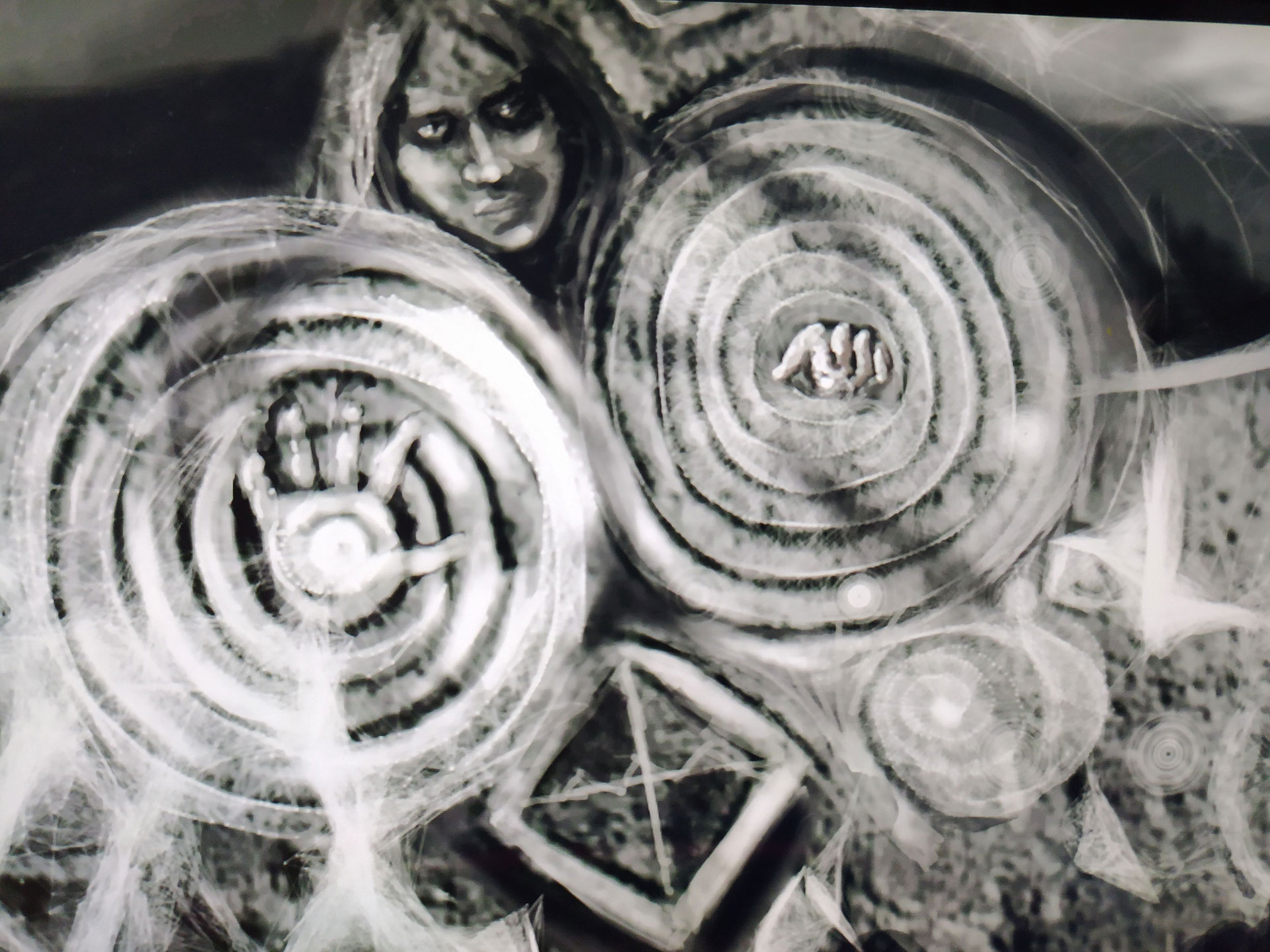Work in Progress
Kerbstone 67
Introduction
In an idle moment, I often imagine myself 5,200 years ago watching someone stand up from the kerbstones at Sid in Broige blowing the dust from their newly carved work, checking their aching hands for blisters and I imagine cornering them to ask about their ideas and processes. (I always do this at art shows if I get a chance.) But in this scenario I only get an enigmatic smile in reply. We are suddenly surrounded by archaeologists who poke in the artist’s bag looking at the flint tools, another measures the footprints left by the artist’s feet. And one more finds the discarded hazelnut shells of the artist’s packed lunch and is so happy with the insights this will give but for me, a non-academic, practicing artist, there is just the wish that there was an answer from the artist themselves. The scene fades and I am back to the living room/studio and my piles of tracing paper and half finished work. I remember when I took the tour of Sid in Broige the guide said that nobody understood the art on the stones so our guess was as good as anyone else. Without the artist(s) to ask, anything I say next is only a hypothesis, my only qualification being my good ‘artist’s eye’.
A Closer Look at K67
I realise that Kerbstone 67 is not a perfect flat surface whereas my laptop and it’s circle drawing programme assumes that it is and I am working at a fraction of the actual size of the stone. Also I am only looking at photos and 3d digital representations of the stone and not the stone itself so I realise there are limitations because of that. With this disclaimer let’s have a look!
The Spirals
The Spirals
On the right it has two finely done Archimedean spirals that connect running into one another, if you put your finger at the centre of the left hand spiral and follow the line, it expands to the right and then changes direction as it winds to the left into the right hand spiral. Archimedean spiral arms maintain a constant width as they go around. Spirals at this level of precision, it needs to be said, cannot be done off the top of your head. Try drawing one yourself making sure it is evenly expanding and the arms are the same width as they extend while maintaining their circular appearance. No good? Have a go at the double spirals on the front of Kerbstone 1 and see how far you get. Who is the primitive artist now? Imagine trying to incise one with a pointed bit of flint or quartz on the uneven surface of a great sarson, to work evenly around those curves also maintaining equal pressure on the point of the chisel so the line is of the same depth as you go around. Imagine the stress of working on what must have been a specially selected stone that your community has dragged without benefit of the wheel from surrounding fields uphill for you to carve to become part of that astonishing feat of architecture and palace of the winter Solstice, Sid in Broige. I’ve tried carving and I know how hard it is.
There is a method for these kinds of spirals using a compass which only requires a straight line with a central point, and one measurement which is the width of the arm of the spiral. It is the “Two Point Spiral” design method which you can find demonstrations for easily on the internet. Did they have compasses? You will have to ask the archaeologists. It is possible to make an Archimedean spiral using only string looped around a pencil. You have to be able to extend the string in length after each half turn and move the string from it’s central position to a second position and back again (or use a new string) for each move. I’ve done it and while it is difficult (on a sheet of A3) it does work. The two point spiral method also elegantly makes double spirals possible too. If you just wind string around a pencil and allow it to unwrap as you go around pulling it taught from the centre, that is a Logarithmic spiral which means the arms get wider with every turn. The Boyne Valley spirals are Archimedean spirals made 3,500 years before Archimedes! If there are any logarithmic ones I am happy to hear about them! Interestingly, the Logarithmic spiral is the one found everywhere in nature from snail shells to flower patterns as it incorporates geometric progression however the Archimedean spiral is very rare in nature so perhaps this points to some other meaning in the use of these particular spirals unless it’s all a homage to coiled centipedes!
The Shapes Around the Spirals
The top diamond shape and the “double lined” square shape beneath it seem to be along the central axis of the spirals although the square is a little offside to the left. There are strange little shapes to the right of the spirals, an odd double line ‘L’ shape which on closer inspection may be part of a bigger design, below is a tiny double lined square and a blurry shape of a circle. Looking at the Discovery Channel’s 3D version you can see that it too is a spiral. There are also tiny repeated v shapes underneath the left hand spiral which suggest maybe a finer decoration might have existed beyond what we see now, they also extend into the centre of the square. There is also one circle/spiral to the far right that can hardly be seen on the plaster cast image. Without the benefit of actually seeing the stone close up in different lights I can only guess that there may be more (or less!) than I am describing. There is a cluster of odd shapes underneath the left hand spiral that don’t fit in with anything. On the top right is a series of curved ‘V’ shapes and above the left hand spiral seem to be the ghosts of lozenges long worn away with only two holes left.

The Left Hand Side - Triangles and Lozenges.
Then there are the triangles and lozenges on the left, which are broken into three layers of similar looking shapes with or without borders around the shapes. It all seems at first glance to be, well, unprofessional is the word I might use. Some triangles flop on one side like a wet cardboard box or bow at the bottom. Everything is at an angle climbing from left to right but not evenly. Some have interpreted the repeated triangles seen in much of the art as a counting system (Martin Brennan-The Stones of Time) so perhaps their shape is not so important (although he did in his earlier book The Boyne Valley Vision present theories on structure using large circles that encompassed the whole designs). But why were some of the triangles perfect and others not? Why if they appear to lay along a line of sight are some dipping below the line and others perfectly on the line. Why were some shapes repeated to perfection and others apparently arbitrarily untidy and inconsistent? Why are the diamond and square between the spirals not exactly on the central axis? The artist was capable of precision (the spirals) so why not be precise? So frustrating.
The Left Hand Design – A Chance Observation
Having studied and drawn and redrawn this image I noticed something. I was tracing the spirals image and moved the tracing paper to the left of my drawing of the entire stone meaning I could see the triangles through a spiral, The top right triangle in the row of three has sides that curve gently outwards and it had a perfect straight base. One side of it fitted perfectly inside the second turn of the spiral Could this mean something? I drew a sort of K67 machine rumbling on with apparent wheels turning and noted curves everywhere. I tried to see if there was some consistent way of making sense of this half section of a circle, then I saw two circles overlap amid the chaos of all the tracings and like a bolt of lighting I saw that the triangle was the centre of a ven diagram so this meant it was a shape made by two interlocking circles. I did a bit of surfing and found that there are loads of ways of making images using interlocking circles and that many of these were often described as “sacred geometry”. I have scoured the internet and not found anything on their use before the Roman period. I noted that when circles interlock they make a grid of lozenges with great ease. If you have a circle with the centre marked then you can play endlessly with designs. You will get a lot of 60 degree angles and 90 degree angles. So you can make squares, lovely isosceles triangles, parallelograms, rectangles to any size you like, all without needing protractors or T squares or indeed numbers, just string and a pencil and some kind of ruler.
Then I realized something important. If you make an interlocking pattern of circles showing it’s line grid it gives you three options if you are drawing a line. You can use the straight line of the grid like the base of the triangle I was focusing on or you can use the curve of the circle as in the left and right sides of the triangle. This was starting to get me very excited about the floppy triangles. Another point about this way of drawing is it allows you to have pinpoint accuracy without measuring anything. You put a circle with the centre point on a straight line and you build from there always placing the central point on where circles intersect and you will not go wrong. To my utter astonishment an interlocking pattern which makes 6 petals and a grid of lozenges was the basis for the entire left side of the stone. The etched semicircle on the left of the stone fits into the pattern. If I continued beyond the diagonal border between the left side and the right side the circles stopped making such clear sense.
The Right Hand Circle Design
I then turned my attention to the right hand side of the stone and noted that while there seemed to be circle segments, the left hand circles were too small to fit like when you try to put the lid of a jam jar on and realise your mistake when it drops into the jam. So the circles on the right side were based on the (invisible) outer arm of the spiral. You can see a curved line in evidence rather than a dead straight line on the top right of the diamond shape. Also if you look at the large square, it’s outer top right side is a circle segment and you can even see the circle extend a bit downwards, is this a guideline? The tiny square also has a curved edge. And look at the ‘L’ again. This too could be a section of a circle. Was there more design to be seen originally and we are left with some bits missing? I squinted at my laptop and drawing programme.
What I couldn’t have imagined is that every single shape would eventually find its meaning in the design and it is a design of such astonishing complexity and beauty I couldn’t have believed it. Far from being less than perfect, it was based on an amazing two part design! Please go back and forward to see where each circle finds its origin. It may be a tiny little edge of something but it is there and will always have it’s corresponding matching shape on the other side but will have a different line to guide you. As it gets more complicated I am sure there are errors and omissions as it is impossible to find the central point as all the lines become blended together but you can see in principle that it makes sense. The V shapes on the top right also make circles that touch the lines within the spirals but by the time those are done the image is almost obliterated by lines! The large circles also match up with the left over lines of the left hand pattern.
So what have we got? The left hand side is a design made using a repeat pattern and the right hand side is a single symmetrical (hooray!) image involving a mind-bendingly dazzling use of circles. And to think the first time I saw K67 I thought it looked like an owl in flight. I suppose the next question is why do a pattern and then remove arbitrary bits of it so the original pattern can’t be easily discerned? Was it completed on special occasions using paint or charcoal? Was it a secret known only to certain people? Or was it simply a grid over which patterns and designs could be made which I since found is a feature of Islamic art of the middle ages. The left hand side pattern makes me think of the stories of the swans with rings around their necks all connected to eachother by silver or gold chains. The spirals make me think of Boanne breaking taboos by walking around a well in counter clockwise direction rather than the prescribed clockwise direction.
The implications of this could be big. The art of the Boyne Valley specifically consists of so-called geometric shapes such as lozenges triangles squares and rectangles, and then a more fluid style of curves, circles, wavy lines, dots etc. In the case of K52 there are different sections with both apparently opposing styles, a section of spirals and a section of grid made using straight interlocking lines. If I am right in my hypothesis then these designs are part of the same set of design tools and motifs. The grid could hold circles, the circles can hold a grid and both can be used to make art that is at first glance not symmetrical and apparently haphazard even. Giant ‘X’s naturally form from interlocking circle grids too. I’m thinking of the roof box stone with its eight ‘X’s. Is it related to the other art? I am now looking at other stones and seeing this and other methods appear. Some stones are more stubborn than others but in between making my own art I will carry on looking as long as the original artists maintain their silence.
Helpful Websites
Books
The Boyne Valley Vision by Martin Brennan.
The Stones of Time by Martin Brennan
The Origins of the Irish -J P Mallory
Journal Articles
The Story of Three Graffiti
Ömür Bakirer
Muqarnas
Vol. 16 (1999), pp. 42-69 (28 pages)




